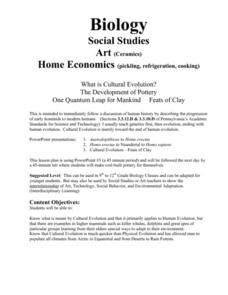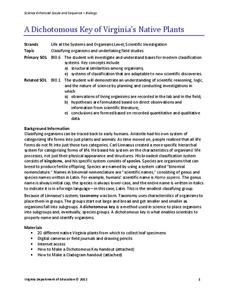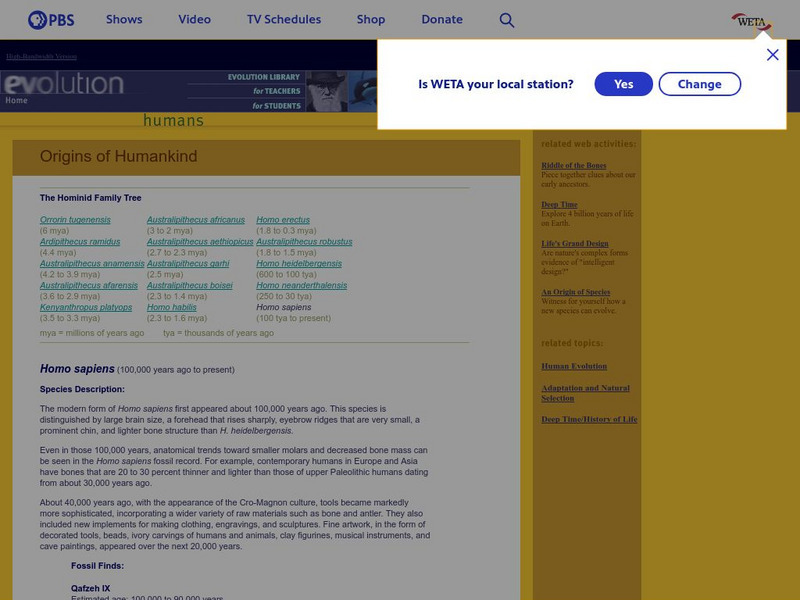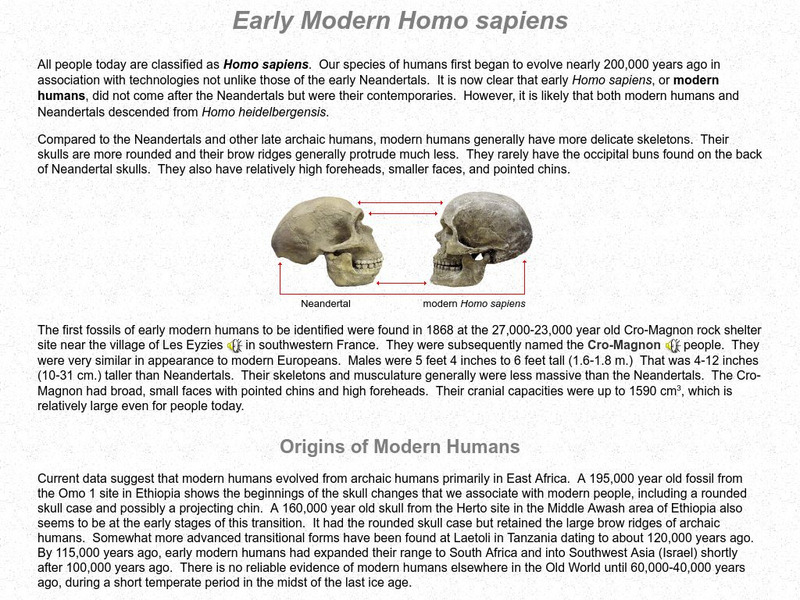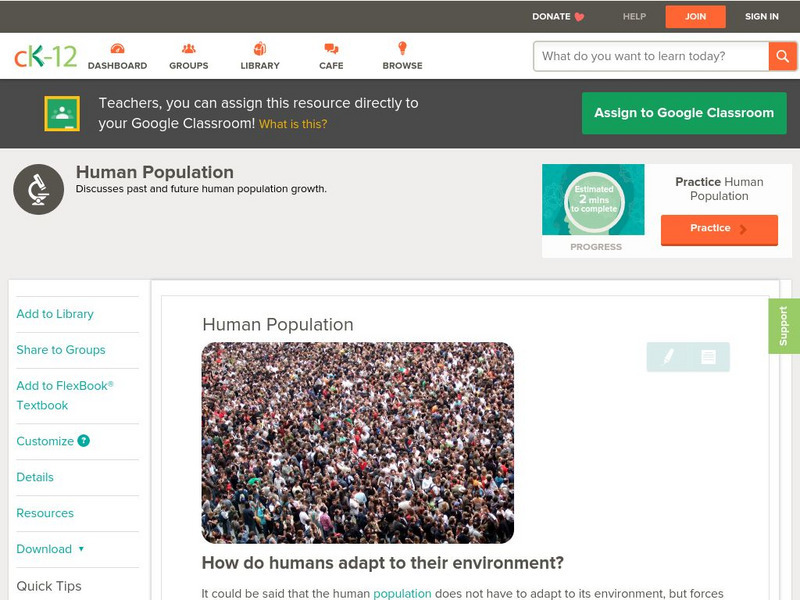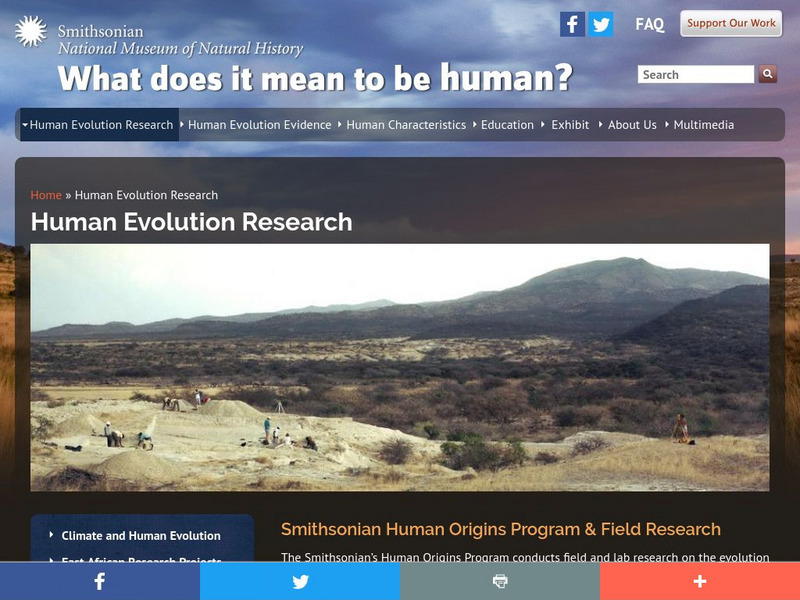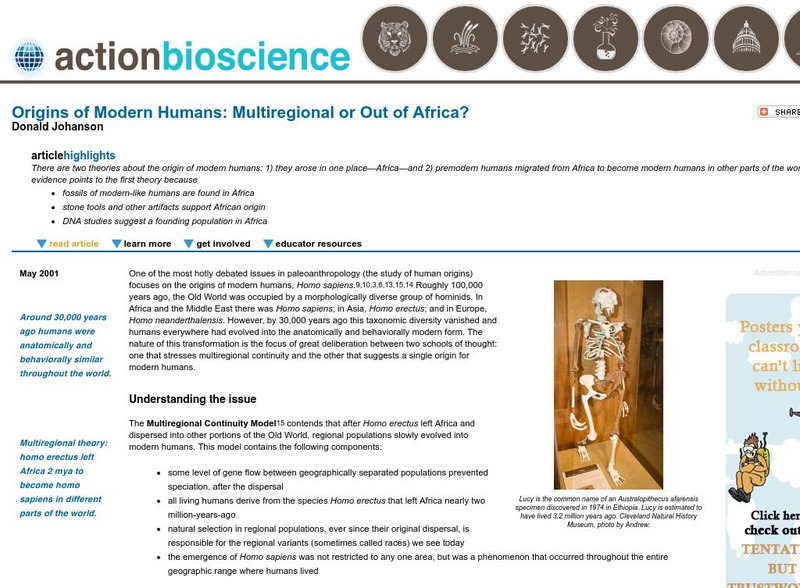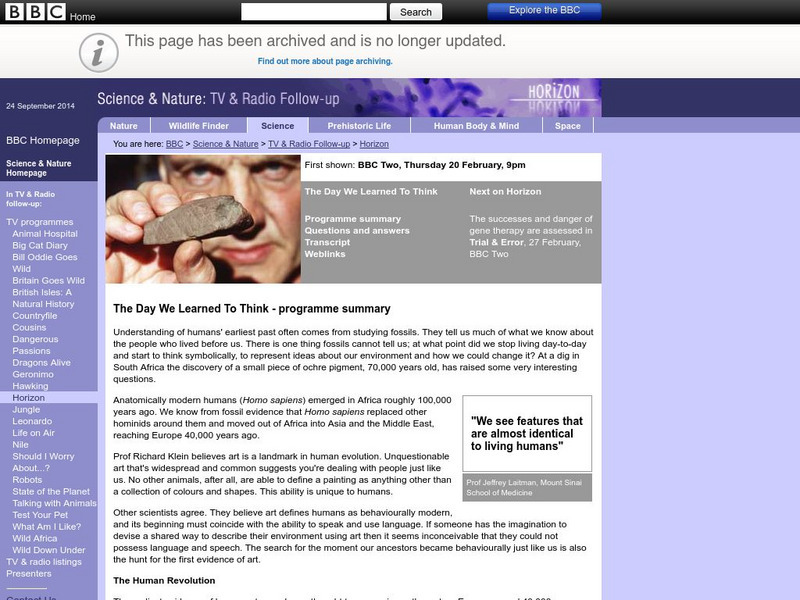American Museum of Natural History
What's This?: Early Humans
Early humans crafted shelters out of whatever materials they could find. A one-question quiz asks learners to identify the type of bones used to construct the hut pictured in a display.
Curated OER
The Origin of Humans
Where did human beings come from? How did they settle into communities and civilizations? Your class will find the answers in this fascinating presentation, which takes the viewer through the stages of mankind, from the primitive...
Curated OER
The Earliest Humans
Study the wonder and science that leads us to our human past. From Darwin and Huxley's assertions regarding the origin of the species to the discoveries at Oldivi Gorge, this PowerPoint is sure to interest your class. They'll learn about...
Curated OER
Early Humans
Eighth graders work together in groups to examine the earliest civilizations. After reading two stories, they compare and contrast the facts with those stories with other ones they have read. They discuss the different hypothesis on...
Curated OER
Human Evolution
Students investigate hominid evolution to learn the difference between a relative and an ancestor. They study the emergence of bipedalism and the related physical adaptations and cultural ramifications, and chart patterns of hominid...
Curated OER
Prehistory Web Quest
Sixth graders identify how geography and climate determine the lives of early hominids, the characteristics of hunter-gatherer societies, how animals affected the lives of early hominids, and how hominids overcame their physical...
Curated OER
What is Cultural Evolution?
Students comprehend what is meant by Cultural Evolution and that it primarily applies at Human Evolution, but that there are examples in higher mammals such as a killer whales, dolphins and great apes of particular groups by exploring...
Virginia Department of Education
A Dichotomous Key of Virginia’s Native Plants
Can your class correctly classify plant species? Individuals explore native plants of the local environment and correctly classify them into their respective categories. They investigate differences in the plants and discuss similarities...
Curated OER
Elements of Civilization
Young scholars create their own ancient civilizations based off of topographical maps of Egypt, Mesopotamia, the Indus Valley, and the Yellow River. In this social studies lesson plan, students are assigned one topographical map to use...
Curated OER
Prehistory: Our Ancestors Emerge
For this prehsitory worksheet, learners read a 3-page article about antropological finds and then respond to 2 short answer questions based on the article.
Curated OER
ESL: Journalism Article Comprehension
In this ESL comprehension worksheet, students read a passage, then complete a variety of warm-up and pre/post reading activities. Homework suggestions are included.
Science Daily
Science Daily: The Oldest Homo Sapiens
The oldest fossils of modern humans (Homo Sapiens) found near Omo Kibish, Ethiopia, have been identified as being approximately 196,000 years old. This article points out the amazing significance of these findings.
PBS
Pbs: Evolution: Origins of Humankind: Homo Sapiens
Read a description of Homo sapiens as a species, learn about the variety of Homo sapiens fossils that have been found, and discover evidence of the culture of these early people.
Palomar Community College District
Palomar College: Flashcards: Early Modern Homo Sapiens
A set of eleven flashcards featuring facts about the early humans.
A&E Television
History.com: How Early Humans Survived the Ice Age
The most recent ice age peaked between 24,000 and 21,000 years ago, when vast ice sheets covered North America and northern Europe, and mountain ranges like Africa's Mt. Kilimanjaro and South America's Andes were encased in glaciers. At...
Palomar Community College District
Palomar College: Early Modern Homo Sapiens
An easy-to-understand article traces the origins of modern humans through the use of a simple graph. Various models of migration are also discussed.
Lin and Don Donn
Lin and Don Donn: Who's Who of Early Man
The little cave man guy with a club welcomes you to the site. Did early man look like him? Mr. Donn has put together a Cheat Sheet of Who's Who of Early Man beginning with the famous Lucy and ending with men that looked a lot like us!
Smithsonian Institution
National Museum of Natural History: What Does It Mean to Be Human, Human Characteristics
Explore walking upright, tools and food, bodies, brains, social life, language and how humans ultimately changed the world. Excellent charts, pictures and videos accompany easy-to-understand text on the earliest humans.
Other
Becoming Human: Evolution and Human Uniqueness
This is Chapter One from "Becoming Human: Evolution and Human Uniqueness," by Ian Tattersall. This chapter presents recent findings about the art and artifacts of early humans, and what those artifacts tell us about the intellectual...
CK-12 Foundation
Ck 12: Biology: Human Population
[Free Registration/Login may be required to access all resource tools.] Overview of early human population growth.
Smithsonian Institution
National Museum of Natural History: What Does It Mean to Be Human: Human Evolution Research
Research continues to discover evidence left behind by prehistoric man. Discover the climate effects on human evolution and explore how the adaptable survived. The Asian and East African Research Projects in Kenya are described. You,...
PBS
Pbs Nova: Who's Who in Human Evolution
Easy-to-understand chart of human evolution that traces hominins back more than six million years. Follow along using this clickable illustration right up to us, Homo sapiens. Clicking on each name will provide a brief descriptive...
American Institute of Biological Sciences
Action Bioscience: Origins of Modern Humans: Multiregional or Out of Africa
Two migration theories are on the table for consideration. Weigh the evidence of each one in this article by Donald Johanson of Lucy fame.
BBC
Bbc: Science and Nature: The Day We Learned to Think
A summary of BBC program entitled, "The Day We Learned to Think." Offers a brief look at man's first works of art, early ability to speak, and evolution of intelligence. Offers questions and answers, a program transcript, and various...






